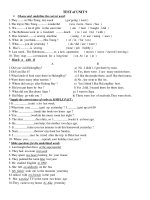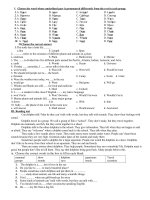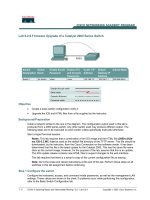9 asymmetric alkylation of enolates
Bạn đang xem bản rút gọn của tài liệu. Xem và tải ngay bản đầy đủ của tài liệu tại đây (968.71 KB, 10 trang )
Myers
Asymmetric Alkylation of Enolates
• An early milestone in the use of a chiral auxiliary for asymmetric alkylation:
Cl
H2N
OH
HO
C6H5
OEt
• Application to iterative assembly of 1,3,n-substituted carbon chains by Evans et al. in
synthesis of ionomycin:
O
KOt-Bu, CH3I
NH2
• Strongly nucleophilic prolinol amide enolates react with "-branched alkyl halides.
C6H5
CH3
CH3
N
CH3O
OH
O
LDA; EtI
2-Oxazolines as
carboxyl equivalents
C6H5
O
HO
CH3
N
Ph
CH3 CH3
Ph
I
CH3
dr 97 : 3
CH3
N
CH3O
84%
CH2CH3
N
OH
O
KH, LDA;
O
3-6 N HCl
CH3
Chem 115
83%
CH2CH3
aq. HCl, 100 °C;
latent aldehyde
NaOH
78% ee
91%
O
Meyers, A. I.; Knaus, G.; Kamata, K.; Ford, M. E. J. Am. Chem. Soc. 1976, 98, 567-576.
SO2Ph
TDSO
Ph
HO
CH3 CH3
CH3 CH3
• Prolinol amide enolates provided an important advance:
PhSO2
OH
CH3CH2COCl
NH
OH
O
N
Et3N
16
14
CH3
OTBDPS
CH3 CH3
• 3° amides
form Z-enolates
selectively
2 LDA
(S)-2-Pyrrolidinemethanol
12
O
OLi
OLi
CH3
N
H
H
H
CH3
CH3
O
HO
CH3
CH2C6H5
1 N HCl, !
BnBr
N
92%
CH3
CH2C6H5
Evans, D. A.; Takacs, J. M.; Tetrahedron Lett. 1980, 21, 4233.
Sonnet, P.; Heath, R. R. J. Org. Chem. 1980, 45, 3137.
75% yield, 76% de
O
OH
OH
Ca
OH
16
OH
O
CH3
CH3
CH3
14
O
O
O
O
12
CH3 CH3
CH3 CH3 CH3
Ionomycin Calcium Complex
Evans, D. A.; Dow, R. L.; Shih, T. L.; Takacs, J. M.; Zahler, R. J. Am. Chem. Soc.
1990, 112, 5290-5313.
1
Evans Oxazolidinone Auxiliaries in Asymmetric Synthesis: Alkylations
Myers
Chem 115
Evans Oxazolidinone Auxiliaries in Asymmetric Synthesis: Alkylations
Acylation provides imides, closer to esters than amides in terms of acidity,
enolate nucleophilicity and cleavage chemistry:
As originally introduced, two enantio-complimentary reagents:
O
O
NH
n-BuLi, THF, –78˚C;
O
NH
O
CH3
(4R, 5S)-(+)-4-Methyl-5-phenyl-2-oxazolidinone
Evans, D. A.; Ennis, M. D.; Mathre, D. J. J. Am Chem. Soc. 1982, 104, 1737-1739.
O
O
NH
CH2CH3
N
PrCOCl, 80-90%
CH3
H3C
Evans, D. A.; Bartroli, J.: Shih, T. L. J. Am. Chem. Soc. 1981, 103, 2127-2129.
Z-Enolates are formed with very high selectivity. Chelated geometry presumed in
ground and transition states:
O
O
O
O
O
H3C
Several oxazolidinones are now commercially available, in both enantiomeric forms:
O
NH
CH3
CH3
H3C
(S)-(!)-4-Isopropyl-2-oxazolidinone
O
O
O
O
CH2CH3
N
NH
O
LDA, THF
O
Li
O
CH2CH3
N
–78 ˚C
CH3
CH3
H3C
H3C
BnBr, –78 ˚C
(S)-(!)-4-Benzyl-2-oxazolidinone
(S)-(+)-4-Benzyl-2-oxazolidinone
O
O
O
O
92%
O
NH
O
NH
O
CH2CH3
N
Bn
CH3
H3C
(S)-(!)-4-Phenyl-2-oxazolidinone
(S)-(+)-4-Phenyl-2-oxazolidinone
O
O
O
O
O
NH
>99:1
O
NH
N
CH3
CH3
CH3
O
O
CH2CH3
LDA; BnBr
78%
O
O
CH2CH3
N
Bn
CH3
>99:1
H3C
(4S,5R)-(!)-4-Methyl-5-phenyl-2-oxazolidinone
(R)-(+)-4-Phenyl-2-oxazolidinone
Evans, D. A.; Ennis, M. D.; Mathre, D. J. . J. Am. Chem. Soc. 1982, 104, 1737-1739.
2
• Less reactive (non-allylic/benzylic) electrophiles require use of sodium enolates or triflate as
leaving group:
O
O
O
CH3
N
O
NaN(TMS)2, THF
O
–78 ˚C; EtI
O
O
CH3
N
CH3
N
O
Exercise: Why are the products configurationally stable?
O O
O
CH3
LDA, THF, –78 ˚C;
O N
CH3
EtCOCl
CH3
88%
H3C
O
Et
53%
CH3
• Highly diastereoselective acylation of imide enolates is possible:
CH3
CH3
H3C
94 : 6
Evans, D. A.; Ennis, M. D.; Mathre, D. J. J. Am. Chem. Soc. 1982, 104, 1737-1739.
Evans, D. A.; Ennis, M. D.; Mathre, D. J. J. Am. Chem. Soc. 1982, 104, 1737-1739.
O
O
• Diastereoselective hydroxylation has been demonstrated:
O
O
CH3
N
O
LDA, –78 ˚C;
O
CH3
CH3
O
O
O
SO2Ph
N
(±) 1.5 equiv
O
N
CH3
O
O
CH3 CH3
CH3
CF3SO3
• note selective enolization of imide
over ester
NaN(TMS)2 (1 equiv), THF, –78 ˚C
CH3
LDA, –78 ˚C;
• sodium enolate required
OCH3
N
<5% alkylation
I
O
O
CH3
O
OCH3
N
OH
>95% de
68%
Decicco, C. P.; Grover, P. J. Am. Chem. Soc. 1996, 61, 3534-3541.
CH3
• Auxiliary cleaved with Mg(OMe)2
with little to no epimerization
96 : 4
pure isomer: 68% yield
Evans, D. A.; Morissey, M. M.; Dorow, R. L. J. Am. Chem. Soc. 1985, 107, 4346-4348.
see also: Williams, D. R.; McGill, J. M. J. Org. Chem. 1990, 55, 3447-3459.
• Asymmetric azidation provides a route to !-amino acid derivatives:
• Titanium enolates provide a route for diastereoselective SN1-like coupling reactions:
O
O
O
N
Bn
CH3
O
TiCl4, (i-Pr)2NEt;
(CH3O)3CH
95%
O
O
O
N
Bn
O
CH3
CH(OCH3)2
99 : 1
Evans, D. A.; Urpi, F.; Somers, T. C.; Clark, J. S.; Bilodeau, M. T. J. Am. Chem. Soc.
1990, 112, 8215-8216.
O
O
N
t-Bu
KHMDS, TrisylN3, –78 ˚C;
HOAc, –78"0 ºC
90%
O
O
t-Bu
N
N3
>99 : 1
Trisyl = 2,4,6-triisopropylbenzenesulfonyl
Evans, D. A.; Britton, T. C.; Ellman, J. A.; Dorow, R. L. J. Am. Chem. Soc. 1990, 112,
4011-4030.
3
CH3
Alkylation of Pseudoephenamine and Pseudoephedrine Amides:
CH3
NHCH3
• Enolates are formed using 1.95–2.2 equiv LDA.
NHCH3
OH
• Alkylations are highly diastereoselective.
OH
(R,R)-(–)-Pseudoephedrine
• LiCl (~6 equiv) promotes a rapid, clean reaction.
(S,S)-(+)-Pseudoephedrine
• Pseudoephedrine is a commodity chemical, manufactured on multi-ton scale/annum. Its use
is highly regulated in many countries.
Mnemonic:
R
O
N
OH CH3
NHCH3
NHCH3
OH
(S,S)-(–)-Pseudoephenamine
R1
1,4-syn
R = CH3 or Ph
• Epoxides approach from the opposite enolate π-face.
• Use of pseudoephenamine is not restricted; it appears to be a superior auxiliary in many
instances.
O
R3
Morales, M.R.; Mellem, K.T.; Myers, A.G. Angew. Chem. Int. Ed., 2012, 51, 4568–4571.
Preparation of Pseudoephedrine and Pseudoephenamine Amides:
O
R1 O
R2
R1
X
N
NHCH3
OH
CH
OH
3
O
N
OH CH3 R2
2. R2X
R = CH3 or Ph
OH
(R,R)-(+)-Pseudoephenamine
R
1. LDA, LiCl
R1
OLi
R2
R1
R2
X
Yield (%)
mp (ºC)
Ph
CH3
EtCO2
88
188–191
Ph
Et
n-PrCO2
83
133–135
Ph
Bn
Cl
80
147–149
Ph
n-Bu
R'CH2CO2
70
88–90
CH3
CH3
CH3O*
89
114–115
CH3
Ph
Cl
88
145–146
CH3
Cl
Cl
90
79–81
CH3
i-Pr
Cl
92
73–74
CH3
3-pyridyl
(H3C)3CCO2
97
117.5–118.5
H
H
R1
N
H3C
OLi
R2
H
R3X
• Askin et al. reported this type of selectivity reversal for
epoxide electrophiles with prolinol amide enolates and
proposed that the Li cation coordinates and directs the
epoxide opening:
OBn
I
OTBS
H OLi
OLi
N
R
H
OBn
*Even unactivated esters react (under basic conditions), presumbly by transesterification
followed by intramolecular O!N Acyl Transfer
Myers, A. G.; Yang, B. H.; Chen, H.; McKinstry, L.: Kopecky, D. J.; Gleason, J. L.
J. Am. Chem. Soc. 1997, 119, 6496-6511.
Morales, M.R.; Mellem, K.T.; Myers, A.G. Angew. Chem. Int. Ed., 2012, 51, 4568–4571.
Myers, A. G.; McKinstry, L. J. Org. Chem. 1996, 61, 2428.
O
Askin, D.; Volante, R. P.; Ryan, K. M.; Reamer, R. A.; Shinkai, I. Tetrahedron Lett.
1988, 29, 4245.
Kevin Mellem
4
Reduction of Alkylation Products:
Diastereoselective Alkylation Reactions:
R1
O
• Lithium amidotrihydroborate (LiH2NBH3 (LAB)), prepared by deprotonation (LDA)
of commercial, crystalline ammonia-borane complex, provides primary alcohols:
R1
1. LDA, LiCl
R2
N
OH CH3
O
N
OH CH3 R3
2. R3X
R2
CH3 O
R1
R2
R3X
temp (˚C)
crude (isol) de (%)
isol yield (%)
Ph
CH3
BnBr
0
90 (≥99)
85
Ph
CH3
EtI
0
88 (96)
96
Ph
n-Bu
CH3I
0
90 (96)
84
Ph
Bn
n-BuI
–78
≥99 (≥99)
99
CH3
CH3
BrCH2CO2t-Bu
–78
94 (96)
78
CH3
Ph
EtI
0
96 (≥99)
92
CH3
i-Pr
BnBr
0
98 (≥99)
83
CH3
t-Bu
BnBr
0
98 (≥99)
84
Cl
BnBr
–45
90 (≥99)
88
CH3
LAB, THF
OTIPS
N
OH CH3 CH3 CH3
OTIPS
HO
23 ˚C, 1 h
CH3 CH3
98%
98% de
97% ee
Myers, A. G.; Yang, B. H.; Kopecky, D. J. Tetrahedron Lett. 1996, 37, 3623.
Myers, A. G.; Yang, B. H.; Chen, H.; Kopecky, D. J. Synlett 1997, 5, 457.
• Semi-reduction with Brown's lithium triethoxyaluminium hydride provides aldehydes directly
but it can be complicated by low yields, epimerization of the "-stereocenter, and formation of
a stable aminal intermediate:
CH3 O
N
OH CH3 Bn
n-Bu
O
LiAlH(OEt)3
hexanes-THF, 0 ˚C
Bn
82%
97% ee
≥99% de
Hydrolysis of Alkylation Products:
• Occurs under acidic or basic conditions. Both methods likely involve initial N!O acyl
transfer.
• Strongly acidic conditions are required, but are well tolerated by many simple substrates.
n-Bu
H
Myers, A. G.; Yang, B. H.; Chen, H.; McKinstry, L.; Kopecky, D. J.; Gleason, J. L. J. Am.
Chem. Soc. 1997, 119, 6496-6511.
Brown, H. C.; Tsukamoto, A. J. Am. Chem. Soc. 1964, 86, 1089.
Addition of Alkyllithium Reagents to form Ketones:
O
Bn
N
OH CH3 n-Bu
O
H2SO4, dioxane
reflux
Bn
HO
93%
O
O
n-Bu
97% ee
≥99% de
• Alkaline conditions work well with many substrates, but not those susceptible to facile
epimerization ("-aryl).
CH3 O
n-Bu
N
OH CH3 CH3
≥99% de
93%
–78 ! 0 ˚C
95%
≥97% de
CH3
n-Bu
≥95% ee
O
n-Bu4NOH, t-BuOH, H2O
reflux
N
OH CH3
CH3
n-BuLi (2.4 eq), Et2O
HO
n-Bu
O
CH3
97% ee
Myers, A. G.; Yang, B. H.; Chen, H.; McKinstry, L.; Kopecky, D. J.; Gleason, J. L. J. Am.
Chem. Soc. 1997, 119, 6496-6511.
Morales, M.R.; Mellem, K.T.; Myers, A.G. Angew. Chem. Int. Ed., 2012, 51, 4568–4571.
O
CH3
N
OH CH3 n-Bu
≥96% de
PhLi (2.4 eq), Et2O
–78 ! 0 ˚C
96%
CH3
Ph
n-Bu
≥93% ee
Kevin Mellem
5
Application to the Iterative Synthesis of 1,3,n-Substituted Carbon Chains:
>199:1
>199:1
CH3
H
O
(EtCO)2O, Et3N
N
OH CH3
CH3
X!+
95%
O
LDA, LiCl; BnBr
90%
1
LAB
Bn
X!+
90%
CH3
I
CH3
PPh3, I2, Im
Bn
CH3
98%
Bn
O
O
LAB
LDA, LiCl, 1
Bn
X!+
95%
97%
CH3 CH3
CH3 CH3
LDA, LiCl, ent-1
95%
93%
LDA, LiCl, ent-1
X!"
LAB
142:1
O
CH3 CH3 CH3
LAB
93%
CH3 CH3 CH3
"matched"
91%
LAB
66:1
Bn
CH3 CH3 CH3
60% yield, 9 steps
94.1% final de
HO
Bn
X!"
"mismatched"
70:1
HO
199:1
X!+
CH3 CH3 CH3
93%
58% yield, 9 steps
95.7% final de
94%
Bn
"mismatched"
CH3 CH3 CH3
93%
O
Bn
"matched"
Bn
LDA, LiCl, ent-1
66:1
O
CH3 CH3 CH3
HO
LDA, LiCl, 1
96%
O
LAB
97%
CH3 CH3
70 : 1
X!+
PPh3, I2, Im
Bn
I
142 : 1
Bn
CH3 CH3
"mismatched"
CH3 CH3
LDA, LiCl, 1
Bn
HO
96%
CH3 CH3
Bn
I
97%
LAB
Bn
X!"
"matched"
PPh3, I2, Im
55 : 1
58 : 1
>99:1
>99:1
HO
Bn
HO
89%
199:1
Bn
CH3 CH3 CH3
56% yield, 9 steps
92.6% final de
HO
Bn
CH3 CH3 CH3
57% yield, 9 steps
94.7% final de
Myers, A. G.; Yang, B. H.; Chen, H.; Kopecky, D. J. Synlett 1997, 5, 457-459.
6
Construction of Quaternary Centers
R1
R
LDA,
LiCl
O
N
CH3
OH CH3 CH3
THF
0 ºC
Matched
R = CH3 or Ph
OLi
X"+
O
BnBr
CH3
CH3
X"+
DMPU
–40 ºC
Z-enolate
CH3
H3C Bn
95%, 9.9:1 dr
R2
R2
Ph
Ph
O
N
R2
OH CH3R3 CH3
2. R3X, DMPU
OH CH3 CH3
R1
R1
1. LDA, LiCl, 0 ºC
N
• Pseudoephenamine and pseudoephedrine can be used to direct the formation of quaternary
centers by two methods: enolization–alkylation or conjugate addition–alkylation.
Enolization–Alkylation:
O
R3X
temp (˚C)
crude dr
isol yield (%)
CH3
BnBr
–40!0
≥19:1
85
CH3
allylBr
–40!0
≥19:1
99
≥19:1
87
Ph
n-Pr
BnBr
–40!0
Ph
Ph
allylBr
–40!0
≥19:1
82
CH3
Ph
EtI
–40
6.2:1
87
BnBr
–40
19:1
90
CH3
vinyl
Conjugate Addition–Alkylation:
R
LDA,
LiCl
O
N
CH3
OH CH3 CH3
THF
0 ºC
Mismatched
OLi
X"+
CH3
CH3
E-enolate
O
BnBr
X"+
DMPU
–40 ºC
Bn
CH3
CH3
89%, 5.2:1 dr
R = CH3 or Ph
O
N
OH CH3 CH3
1. CH3Li (1.0 eq),
LiCl, THF
–78 ºC
2. t-BuLi
–78!–40 ºC
OLi
X#–
t-Bu
CH3
Kummer, D. A.; Chain, W. J.; Morales, M. R.; Quiroga, O.; Myers, A. G. J. Am. Chem. Soc.
2008, 130, 13231–13233.
Br
–40 ºC
Mnemonic:
O
X#–
O
N
O
1. LDA, LiCl
R1
OH CH3 H CH3
2. R2X, DMPU
t-Bu
H3C
N
R1
85%, ≥19:1 dr
OH CH3 R2 CH3
• Even bulky organolithium reagents such as tert-buyllithium are suitable reagents for this
transformation.
Retention of stereochemistry.
Morales, M. R.; Mellem, K. T.; Myers, A. G. Angew. Chem. Int. Ed., 2012, 51, 4568–4571.
E. Reyes, J. L. Vicario, L. Carrillo, D. Badia, A. Iza, U. Uria, Org. Lett. 2006, 8, 2535–2538.
Kevin Mellem
7
Myers
Asymmetric Alkylation of Enolates
R1
1. CH3Li, LiCl, –78 ºC
2. R3Li, –78" –40 ºC
O
N
OH CH3 R2
O
R1
R3
N
R
R
2
4
OH CH3
3. R4X, –40 ºC
Chem 115
Addition of alkyllithium reagents to form ketones:
CH3 O
N
CH3
Bn CH3
OH CH3
R1
R2
R3
R4X
crude dr
isol yield (%)
Ph
CH3
n-Bu
BnBr
≥19:1
75
Ph
CH3
Ph
AllylBr
≥19:1
80
Ph
Et
t-Bu
CH3I
≥19:1
79
CH3I
Ph
n-pentyl
t-Bu
≥19:1
76
CH3
CH3
n-Bu
allylBr
11.1:1
72
CH3
CH3
t-Bu
allylBr
12.5:1
98
CH3
Et
t-Bu
CH3I
9.1:1
99
CH3
Et
Ph
CH3I
19:1
89
O
CH3Li, HMPA
Et2O
–78"0 ºC
H3C
Bn
CH3
CH3
93%
Reduction to form aldehydes:
Ph
CH3 O
Tf2O, pyr
CH3
N
Ph Bn
OH CH3
CH2Cl2, 0 ºC
O
H3C
N
CH3
TfO H3C Ph Bn
oxazolinium triflate
Red-Al
THF, 0 ºC;
then HCl-TFA
Transformations of !-quaternary pseudoephenamine and pseudoephedrine amides
90 % (two steps)
O
Hydrolysis of !-quaternary alkylation products:
CH3
H
CH3 O
N
CH3
Bn CH3
OH CH3
O
n-Bu4NOH
H2O/dioxane
115 ºC
Ph
HO
Bn
CH3
CH3
Bn
LAB reduction to form primary alcohols:
94%
Kummer, D. A.; Chain, W. J.; Morales, M. R.; Quiroga, O.; Myers, A. G. J. Am. Chem. Soc.
2008, 130, 13231–13233.
O
LAB
t-Bu
N
OH CH3
H3C
CH3
THF, 60 ºC
HO
t-Bu
CH3
98%
H3C
Kevin Mellem
8
Myers
Asymmetric Alkylation of Enolates
• Enders chiral hydrazone methodology:
• Helmchen camphor-derived auxiliaries:
H3C
CH3 SO2Ph
N
OH
CH3
CH3
Chem 115
H3C
CH3SO2Ph
N
O
CH3
CH3
CH3
CH3
O
CH3
O
H
CH2OCH3
84%
94% ee
O
H3C CH3
LICA, THF –78 ˚C
BnBr (95%); LiAlH4
CH2Ph
HO
N
N
t-BuLi, –78 ˚C;
BOMCl,–-100 ˚C;
aq. CuCl2
er 94 : 6
CH3
O
CH2OCH2Ph
O
O
H3C CH3
(S)-(+)-1-Amino-2-(methoxymethyl)
pyrrolidine [SAMP-Hydrazone]
Enders, D. In Asymmetric Synthesis; Morrison, J. D.; Academic Press: New York,
1984; Vol. 3, Chapter 4.
Enders, D.; Hundertmark, T.; Lazny, R. Syn. Comm. 1999, 29, 27-33.
Schmierier, R.; Grotemeier, G.; Helmchen, G.; Selim, A. Angew. Chem., Int. Ed. Engl. 1981,
20, 207-208.
• Oppolzer camphorsultam auxiliaries in asymmetric alkylation:
H3C
CH3
NaH;
NH
H3C
• An alternative oxazolidinone-based auxiliary allows !-alkylation of ketones with excellent
stereoselectivities. The ease of synthesis and removal of the auxiliary makes it a practical
alternative to the traditional RAMP/SAMP methodology:
CH3
CH3
H3C
CH3
H3C
O
CH3CH2COCl
CH3
N
O
S
O
O
S
O
O
N
H3C
(1S)-(–)-2,10-Camphorsultam
N
O
1. LDA, THF
–78 ºC
N
Br
2.
CH3
O
94%
N
O
H3C
HMPA, C6H5CH2Br
1. LDA, THF
–78 ºC
2. 4-BrC6H4CH2Br
89%
89%, dr = 97 : 3
NaN(TMS)2;
H3C
HO
O
O
O
CH3
CH2C6H5
LiOH, H2O2
O
O
CH3
CH3
N
S
O
O
CH2C6H5
p-TsOH
acetone, 23 ºC
H3C
Br
N
N
Ph
Ph
Bn
H3C
94%
Br
97% de
Oppolzer, W.; Moretti, R.; Thomi, S. Tetrahedron Lett. 1989, 30, 5603-5606.
Lim, D.; Coltart, D. M. Angew. Chem., Int. Ed. Engl. 2008, 47, 5207–5210.
Fan Liu
9
Myers
Catalytic Methods for Asymmetric Alkylation
• An early, remarkable result from the Merck Process group:
H
N
Br –
Chem 115
• Corey and co-workers have developed catalysts that are highly enantioselective:
Br "
0.11 g
H
N+
OH
N
Cl
O
CF3
O
Cl
CH3Cl, C7H8-50% NaOH
Cl
Cl
20 ºC, 18h, 95%
H3CO
O
CH3
O
O
H3CO
0.61g
N
Ph
92% ee
N
CsOH•H2O, CH2Cl2
Ot-Bu
–78 ˚C, 24 h
Ph
• Although limited to a single example, this provided a dramatic illustration of the potential of
chiral phase-transfer catalysis for C-C bond formation.
Ot-Bu
O
O
O
CH3
O
O
Dolling, U.; David, P.; Grabowski, E. J. J. J. Am. Chem. Soc. 1984, 106, 446-447.
N
Ph
O
Br
Ph
CH3
81%, 96% ee
1.5 equiv
• The method was adapted by O'Donnell, who had earlier developed a PT method for the
synthesis of racemic !-amino acids:
Corey, E. J.; Xu, F.; Noe, M. C. J. Am. Chem. Soc. 1997, 119, 12414-12415.
Cl –
H
N
Phosphazene bases can also be used with the catalyst above, see: O'Donnel, M. F.;
Delgado, F.; Hostsettler, C.; Schwesinger, R. Tetrahedron Lett. 1998, 39, 8775-8778.
OH
N
O
Ph
N
O
CH2Cl2 - 50% NaOH
Ot-Bu
Ph
19.2 g (65 mmol)
Ot-Bu
Ph
25 ˚C, 15 h, 95%
Ph
N
Br
64% ee
Cl
O
OTMS
MeLi - LiBr (1 equiv), C7H8, 23 ˚C;
Cl
crystallization
O
H2N
• Koga and co-workers have developed chiral additives for the asymmetric alkylation of
lithium enolates. The work has been extended to include examples that employ additives
in catalytic amounts:
(CH3)2NCH2CH2CH2N(CH3)2 (2 equiv),
BnBr (10 equiv), "45 ˚C, 18h
6N HCl, ∆
OH
16.8 g (>99% ee)
N
H
N
Ph
6.5 g, >99% ee,
50% overall
Cl
O' Donnell, M. J.; Bennett, W. D.; Wu, S. J. Am. Chem. Soc. 1989, 111, 2353-2355.
CH2Ph
N
CH3
76%, 96% ee
CH3
N
CH3
0.05 equiv
Imai, M.; Hagihara, A.; Kawasaki, H.; Manabe, K.; Koga, K. J. Am. Chem. Soc. 1994, 116,
8829-8830.
10









